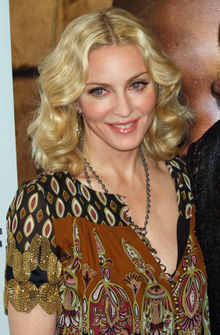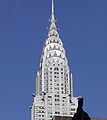East Village, Manhattan
The East Village is a neighborhood in the borough of Manhattan in New York City. It lies east of Greenwich Village, south of Gramercy and Stuyvesant Town, and north of the Lower East Side. Within the East Village there are several smaller neighborhoods, including Alphabet City and The Bowery.
The neighborhood was once considered part of the Lower East Side, but in the 1960s it began to develop its own culture and became known as the East Village. Scores of artists and hippies began to move into the area, attracted by the base of Beatniks that had lived there since the 1950s. It has been the site of counterculture, protests and riots. The neighborhood is known as the birthplace and historical home of many artistic movements, including punk rock[1] and the Nuyorican literary movement.[2]
It is still known for a diverse community, vibrant nightlife and artistic sensibility, although in recent decades gentrification has changed the character of the neighborhood.[3]
Contents |
History
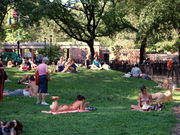
Formation of the neighborhood
Today's East Village was originally a farm owned by Dutch Governor Wouter van Twiller. Petrus Stuyvesant received the deed to this farm in 1651, and his family held on to the land for over seven generations, until a descendant began selling off parcels of the property in the early 1800s. Wealthy townhouses dotted the dirt roads for a few decades until the great Irish and German immigration of the 1840s and 1850s.
Speculative land owners began building multi unit dwellings on lots meant for single family homes, and began renting out rooms and apartments to the growing working class. The "East Village" was formerly known as Klein Deutschland ("Little Germany, Manhattan"); however, Little Germany dissolved after the SS General Slocum burned into the water in New York's East River on June 15, 1904. From the years roughly between the 1850s and the first decade of the 20th century, the "East Village" hosted the largest urban populations of Germans outside of Vienna and Berlin. It was America's first foreign language neighborhood; hundreds of political, social, sports and recreational clubs were set up during this period, some of these buildings still exist.
What is now the East Village once ended at the East River where Avenue C is now located. A large portion of the neighborhood was formed by landfill, including World War II debris and rubble from London, which was shipped across the Atlantic to provide foundation for the Franklin D. Roosevelt Drive.[4]
The 'East Village' separates from the Lower East Side
Definitions vary, but the boundaries are roughly defined as east of Broadway and the Bowery from 14th Street down to Houston Street.[5]
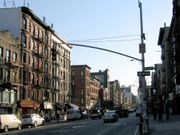
Until the mid-1960s, this area was simply the northern part of the Lower East Side, with a similar culture of immigrant, working class life. In the 1950s the migration of Beatniks into the neighborhood later attracted hippies, musicians and artists well into 1960s.[5] The area was dubbed the "East Village", to dissociate it from the image of slums evoked by the Lower East Side. According to the New York Times, a 1964 guide called, "Earl Wilson's New York", wrote that "artists, poets and promoters of coffeehouses from Greenwich Village are trying to remelt the neighborhood under the high-sounding name of 'East Village.'"[5]
Newcomers and real estate brokers popularized the East Village name, and the term was adopted by the popular media by the mid-1960s.[6][7] In 1966 a psychedelic weekly newspaper, The East Village Other, appeared and The New York Times declared that the neighborhood "had come to be known" as the East Village in the June 5, 1967 edition.[5]
The music scene develops
In 1966 Andy Warhol promoted a series of shows, entitled The Exploding Plastic Inevitable, and featuring the music of the Velvet Underground, in a Polish ballroom on St Marks Place. On June 27, 1967, the Electric Circus opened in the same space with a benefit for the Children's Recreation Foundation (Chairman: Bobby Kennedy). The Grateful Dead, The Chambers Brothers, Sly & the Family Stone, the Allman Brothers were among the many rock bands that performed there before it closed in 1971.

On March 8, 1968 Bill Graham opened the Fillmore East in a Yiddish Theatre on 2nd Avenue. The venue quickly became known as "The Church of Rock and Roll", with two-show concerts several nights a week. While booking many of the same bands that had played the Electric Circus, Graham particularly used the venue – and its West Coast counterpart, to establish new British bands like The Who, Pink Floyd, The Jimi Hendrix Experience, Cream, and Led Zeppelin. It, too, closed in 1971.
CBGB, the nightclub considered by some to be the birthplace of punk music, was located in the neighborhood, as was the early punk standby A7. No Wave and New York hardcore also emerged in the area's clubs. Among the many important bands and singers who got their start at these clubs and other venues in downtown Manhattan were: Patti Smith, Arto Lindsay, the Ramones, Blondie, Madonna, Talking Heads, the Plasmatics, Glenn Danzig, Sonic Youth, the Beastie Boys, Anthrax, and The Strokes. From 1983–1993, much of the more radical audio work was preserved as part of the Tellus Audio Cassette Magazine recording project, which was based in the nearby Lower East Side.
Rise in artistic prominence
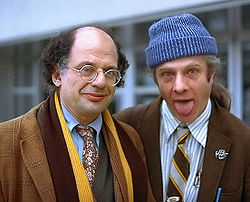
Over the last 100 years, the East Village/Lower East Side neighborhood has been considered one of the strongest contributors to American arts and culture in New York.[8] During the great wave of immigration (Germans, Ukrainians, Polish) in the late 19th and early 20th centuries, countless families found their new homes in this area.
The East Village has been the birthplace of cultural icons and movements from the American gangster to the Warhol Superstars, folk music to punk rock, anti-folk to hip-hop, advanced education to organized activism, experimental theater to the Beat Generation and the community of experimental musicians, composers and improvisers now loosely known as the Downtown Scene.
Club 57, on St. Mark's Place, was an important incubator for performance art and visual art in the late 1970s and early 1980s; followed by Now Gallery, 8BC and ABC No Rio.
During the 1980s the East Village art gallery scene helped to galvanize a new post-modern art in America; showing such artists as Kiki Smith, Peter Halley, Keith Haring, Stephen Lack, Greer Lankton, Joseph Nechvatal, Nan Goldin, Jean-Michel Basquiat, David Wojnarowicz, Rick Prol, and Jeff Koons.[9]
The musical 'Rent'
The East Village is the setting for Jonathan Larson's musical Rent; set in the early 1990s, the story chronicles a group of friends over a year in their struggles against poverty, drug abuse and AIDS.
The musical Rent chronicled a period in the neighborhood's history that is bygone. It opened at the New York Theater Workshop in February 1996.[10] It described a New York City devastated by the AIDS epidemic, drugs and high crime, and followed several characters in the backdrop of their effort to make livings as artists.[11]
Decline of the art scene
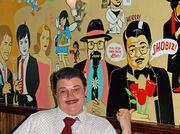
The East Village's performance and art scene has declined since its hey-day of the 1970s and 1980s.[12] One club that had opened to try to resurrect the neighborhood's past artistic prominence was Mo Pitkins' House of Satisfaction, part-owned by Jimmy Fallon of Saturday Night Live. It closed its doors in 2007, and was seen by many as another sign of the continued decline of the East Village performance and art scene, which has mostly moved to Williamsburg, Brooklyn.[13] Rapture Cafe also shut down in April 2008, and the neighborhood lost an important performance space and gathering ground for the gay community. There are still some performance spaces, such as Sidewalk Cafe on Avenue A, where downtown acts find space to exhibit their talent, and the poetry clubs.[14]
Punk scene icons stayed in the neighborhood as it changed. Richard Hell lives in the same apartment he has lived in since the 1970s, and Handsome Dick Manitoba of The Dictators owns and reigns over Manitoba's bar on Avenue B.
Internal neighborhoods
The East Village contains several hamlets of vibrant communities within itself.
Alphabet City
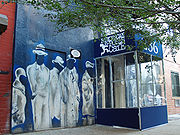
Alphabet City comprises nearly two-thirds of the East Village. It also once was the archetype of a dangerous New York City neighborhood. Its turn-around was cause for The New York Times to observe in 2005 that Alphabet City went "from a drug-infested no man's land to the epicenter of downtown cool."[15] Its name comes from Avenues A, B, C, and D, the only avenues in Manhattan to have single-letter names. It is bordered by Houston Street to the south and 14th Street to the north where Avenue C ends. Some famous landmarks include Tompkins Square Park, the Nuyorican Poets Cafe and the Stuyvesant Town private residential community.
Loisaida
Loisaida is a term derived from the Latino (and especially Nuyorican) pronunciation of "Lower East Side", a neighborhood in Manhattan, New York City. The term was originally coined by poet/activist, Bittman "Bimbo" Rivas in his 1974 poem "Loisaida". Loisaida Avenue is now an alternative name for Avenue C in the Alphabet City neighborhood of New York City, whose population has largely been Hispanic (mainly Nuyorican) since the late 1960s.
St. Mark's Place

Eighth Street becomes St. Mark's place east of Third Avenue. It once had the cachet of Sutton Place, known as a secluded rich enclave in Manhattan, but which by the 1850s had become a place for boarding houses and a German immigrant community.[17] It is named after St Mark's Church in-the-Bowery, which was built on Stuyvesant Street but is now on 10th Street. St. Mark's Place once began at the intersection of the Bowery and Stuyvesant Street, but today the street runs from Third Avenue to Avenue A. Japanese street culture and a Japanese expatriate scene forms in the noodle shops and bars that line St. Mark's Place, also home to an aged punk culture and CBGB's new store. It is home to one of the only Automats in New York City (it has since closed).[18]
St. Mark's is along the "Mosaic Trail", a trail of 80 mosaic-encrusted lampposts that runs from Broadway down Eighth Street to Avenue A, to Fourth Street and then back to Eighth Street. The project was undertaken by East Village public artist Jim Power, known as the "Mosaic Man".[16]
The Bowery
The Bowery, former home to the punk-rock nightclub CBGB, was once known for its many homeless shelters, drug rehabilitation centers and bars. The phrase "On The Bowery", which has since fallen into disuse, was a generic way to say one was down-and-out.[19]
The Bow’ry, The Bow’ry!
They say such things,
and they do strange things
on the Bow’ry —From the musical A Trip to Chinatown, 1891
Today, the Bowery has become a boulevard of new luxury condominiums. It also is home to the Amato Opera and the Bowery Poetry Club, contributing to the neighborhood's reputation as a place for artistic pursuit. Artists Amiri Baraka and Taylor Mead hold regular readings and performances in the space.
The redevelopment of the avenue from flophouses to luxury condominiums has met with resistance from long-term residents, who agree the neighborhood has improved, but that its unique, gritty character is also disappearing.[20]
Parks and green space
Tompkins Square Park
Tompkins Square Park is a 10.5 acre (42,000 m²) public park in the Alphabet City section of the East Village neighborhood in the borough of Manhattan in New York City. It is square in shape, and is bounded on the north by East 10th Street, on the east by Avenue B, on the south by East 7th Street, and on the west by Avenue A. St. Marks Place abuts the park to the west.
Tompkins Square Park Police Riot
The Tompkins Square Park Police Riot was a defining moment for the neighborhood. In the late hours of August 6 into the morning hours of August 7, 1988 a riot broke out in Alphabet City's Tompkins Square Park. Groups of "drug pushers, homeless people and young people known as 'skinheads'" had largely taken over the East Village park, but the neighborhood was divided about what, if anything, should be done about it.[21] The local governing body, Manhattan Community Board 3, adopted a 1 am curfew for the previously 24-hour park, in an attempt to bring it under control.[22] On July 31, a rally against the curfew resulted in several clashes between protesters and police.[23]
East River Park
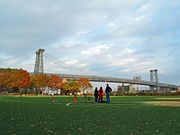
The park is 57 acres (230,000 m2) that runs along the Franklin D. Roosevelt Drive from Montgomery Street to East 12th Street.[24] It was designed in the 1930s by Robert Moses, who wanted to ensure there was parkland on the Lower East Side.[24]
Community gardens
There are reportedly over 640 community gardens in New York City—gardens run by local collectives within the neighborhood who are responsible for the gardens' upkeep—and an estimated 10 percent of those are located on the Lower East Side and East Village alone.[25]
Tower of Toys on Avenue B
The Avenue B and 6th Street Community Garden is one of the neighborhood's more notable for a now removed outdoor sculpture, the Tower of Toys, designed by artist and long-time garden gate-keeper, Eddie Boros. Boros died April 27, 2007.[26] The Tower was controversial in the neighborhood; some viewed it as a masterpiece, others as an eyesore.[26][27] The tower appeared in the opening credits for the television show NYPD Blue and also appears in the musical Rent.[26] In May 2008, it was dismantled. According to NYC Parks Commissioner Adrian Benepe, the tower was rotting in sections that made it a safety hazard.[28] Its removal was seen as another symbol of the fading past of the neighborhood.[28]
Toyota Children's Learning Garden
Located at 603 East 11th Street, the Toyota Children's Learning Garden is not technically a community garden, but it also fails to fit in the park category. Designed by landscape architect Michael Van Valkenburgh, the garden opened in May 2008 as part of the New York Restoration Project and is designed to teach children about plants.[29]
New York City Marble Cemetery
The cemetery is actually two, which sit on 2nd Street between 1st Avenue and 2nd Avenue. They are open the fourth Sunday of every month.[30] The first and more prominent is the City cemetery, which is second oldest non-sectarian cemetery in New York City. It sits next to the oldest public cemetery in New York City not affiliated with any religion, the "New York Marble Cemetery."[31] The cemetery was opened in 1831 and at one point contained ex-U.S. President James Monroe.[32]
Culture and events

Other than geography, the East Village's most notable commonalities with Greenwich Village are a colorful history, vibrant social and cultural outlets, and street names that often diverge from the norm.
The Bowery is a north-south avenue which also lends its name to the somewhat overlapping neighborhood of the Bowery; St. Mark's Place, a crosstown street well-known for counterculture businesses; and Astor Place/Cooper Square, home of the Public Theater and the Cooper Union. Nearby universities like New York University (NYU), The New School, and The Cooper Union have dormitories in the neighborhood.
Ethnicity and religion
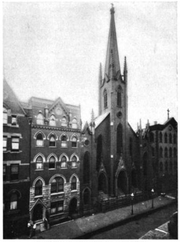

According to 2000 census figures provided by the New York City Department of City Planning, which includes the Lower East Side in its calculation, the neighborhood was 35% Asian, 28% non-Hispanic white, 27% Hispanic and 7% black.[33]
On October 9, 1966, A.C. Bhaktivedanta Swami Prabhupada, founder of the International Society for Krishna Consciousness, held the first recorded outdoor chanting session of the Hare Krishna mantra outside of the Indian subcontinent at Tompkins Square Park.[34] This is considered the founding of the Hare Krishna religion in the United States, and the large tree close to the center of the Park is demarcated as a special religious site for Krishna adherents.[34] The late poet Allen Ginsberg, who lived and died in the East Village, attended the ceremony.
There are several Roman Catholic churches in the East Village which have fallen victim to financial hardship particularly in the past decade. Unable to maintain their properties, the Roman Catholic Church has shuttered many of them - including St. Mary's Help of Christians on East 12th Street, as well as St. Ann's. There has recently been much controversy over St. Brigid's, the historical parish on Tompkins Square Park.
Ukrainian history
Since the 1890s there has been a large Ukrainian concentration roughly from 10th Street to 5th Street, between 3rd Avenue and Avenue A. The post-World War II diaspora, consisting primarily of Western Ukrainian intelligentsia, also settled down in the area. Several churches, including St. George's Catholic Church; Ukrainian restaurants and butcher shops; The Ukrainian Museum; the Shevchenko Scientific Society; and the Ukrainian Cultural Center are evidence of the impact of this culture on the area.
Gentrification
New York University, a controversial resident
Residents of the East Village have a love-hate relationship with New York University, which owns and maintains many buildings, particularly in much of downtown Manhattan and in the neighborhoods surrounding its main campus in Greenwich Village (a distinct neighborhood from the East Village).[35]
St. Ann's Church, a rusticated-stone structure on East 12th Street with a Romanesque tower that dated to 1847 was sold to the University to make way for a monolithic 26-story, 700 bed dormitory for students. The University did protect and maintain St. Ann's original facade and small plaza immediately fronting the 12th Street sidewalk. The result is a blended, softer abutment of the new dorm building (which does rise dramatically above the facade) up behind the old St. Ann's entry way. New York University has built many dorms, and this one in particular is now the tallest structure in the area. "There are larger changes going on here", said Lynne Brown, vice president of university relations and public affairs. "I fear this tendency to blame any trend residents don't like happening at the doorstep of NYU", said Brown, mentioning that the university has been one of the longest inhabitants of the East Village. But Nancy Cosie, a 20 year resident and former St. Ann's parishioner, does not buy that argument. "Enough is enough", Cosie exclaimed to The Village Voice, "This is not a campus. This is a neighborhood, and this is my home."[35] NYU's destruction or purchasing of many historic buildings (such as the Peter Cooper post office) have made it symbolic of change that many long-time residents fear is destroying what made the neighborhood interesting and attractive.[36] "I live on Avenue B and 9th Street", an NYU student said. "I know I'm part of the problem - gentrification that is. But where am I supposed to live?"[36]
NYU has often been at odds with residents of both the East and West Villages, as legendary urban preservationist Jane Jacobs battled the school in the 1960s.[37] "She spoke of how universities and hospitals often had a special kind of hubris reflected in the fact that they often thought it was OK to destroy a neighborhood to suit their needs," said Andrew Berman of the Greenwich Village Society for Historic Preservation.[38]
Museums, libraries, performance and art spaces

- New York Public Library Tompkins Square branch [3]
- The Fales Library of NYU
- East Village Visitors Center - 308 Bowery
- The Ukrainian Museum
- New Museum of Contemporary Art
- Museum of Jewish Heritage
- Performance Space 122
- Anthology Film Archives
- The Stone
- Bouwerie Lane Theatre
- Amato Opera
- Danspace Project
- The Ontological-Hysteric Theater
- The Pearl Theatre Company [4]
- Stomp! (Theatrical show)
- Metropolitan Playhouse[5]
- Mercury Lounge (live music)
- Sidewalk Cafe (performance and live music)
- Bowery Ballroom (concerts and shows)
- Nuyorican Poets Cafe (music, poetry, readings, slams)
- Bowery Poetry Club (music, poetry, readings, slams)
- La MaMa E.T.C. (performance theater)
- Cooper Union (speeches, presentations, public lectures and readings)
Neighborhood festivals
- Mayday Festival - May 1; yearly.
- Charlie Parker Jazz Festival - August; yearly.[6]
- HOWL! Festival - September; yearly.[7][8]
- East Village Radio Festival - September 6, 2008 [9]
- Tompkins Square Halloween Dog Parade - October; yearly.[10]
- East Village Theater Festival - August 3–23, 2009.[11]
- FAB! Festival & Block Party - Last weekend in September annually, Sept 25, 2010 [12]
Media
Radio
- East Village Radio
Local news
- The Village Voice
- The Villager
- East-Village.com
- EastVillageFeed.com
Cinemas
- Anthology Film Archives
- Landmark's Sunshine Theater
- Village East Cinema
- City Cinema Village East
- Two Boots Pioneer Theater
Notable residents past and present
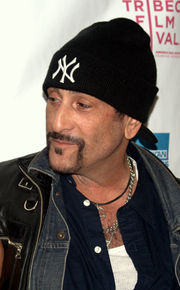
- Handsome Dick Manitoba, who owns Manitoba's bar on Avenue B off Tompkins Square Park.
- Darren Aronofsky and his wife, Rachel Weisz
- Chris Cain, Bassist for the Indie-Rock band We Are Scientists
- Barbara Feinman
- John Leguizamo
- Daniel Radcliffe
- Agim Kaba
- Rosario Dawson
- Tom Kalin
- Vashtie Kola director
- W. H. Auden[40]
- Greer Lankton, Artist/Doll maker
- Ellen Stewart founder of La MaMa, E.T.C. (Experimental Theatre Club) in 1961.
- Madonna lived there in the 1980s.
- John Lurie,musician, painter, actor, producer.
- Jean-Michel Basquiat, graffiti artist
- David Bowes, painter
- Allen Ginsberg (1926–1997), Beat Generation poet and author of Howl.[41]
- Keith Haring, neo-pop artist
- Claes Oldenburg (1929-), sculptor, had a studio at 46 East 3rd Street in the late 1950s.[42]
- Candy Darling, actress/Warhol superstar
- Bill Raymond, actor
- Ryan Adams, alt-country musician
- David Cross, actor, comedian
- Negin Farsad, writer, director, comedian
- Nan Goldin, photographer
- Stephen Lack, actor, painter
- Ronnie Landfield, (1947-), painter, lived on E. 11th street, mid-1960s[43]
- Kiki Smith sculptor
- John Zorn composer, musician
- Bobby Steele, musician, Ex-Misfit, THE UNDEAD
- Richard Hell, musician, author
- Abbie Hoffman (1936–1989), 1960s political activist[44]
- Ayun Halliday, actress and writer, and wife of playwright Greg Kotis
- Greg Kotis, playwright, and husband of actress and writer Ayun Halliday
- Jerry Rubin (1938–1994), 1960s political activist - with Hoffman founded the Yippies in a basement apartment at 30 St. Marks Place[44]
- Cookie Mueller, actress, model
- Paul Krassner (1932-), publisher of The Realist
- Walter Bowart (1939–2007), co-founder editor/ of The East Village Other
- Allan Katzman, co-founder/editor of The East Village Other
- Tuli Kupferberg, (1923-), Beat Generation poet, and one of the original Fugs
- Ed Sanders, (1939-), New York School poet and one of the original Fugs
- Joseph Nechvatal (1951-) early digital artist and founder of the Tellus Audio Cassette Magazine
- Randy Harrison, actor
- Joel Resnicoff, artist and fashion illustrator.
- Regina Spektor, (1980-) Singer-songwriter and pianist.
- Rachel Trachtenburg (1993-) singer and musician
- Tom Otterness sculptor
- Steven Fishbach, runner-up of Survivor: Tocantins
- Chloë Sevigny actress
- Conor Oberst musician
- Lou Reed, musician
- Julian Casablancas, musician
- Mark Ronson
- Arthur Russell, musician[45]
- Jack Smith filmmaker, artist
- Iggy Pop, performer, musician
- Kathy Kemp, fashion designer and entrepreneur
See also
- East Side (Manhattan)
- East Side Hebrew Institute
- East River (New York)
- First Houses
- Ninth Precinct
- Stuyvesant Town
References
- ↑ In Rocking East Village, The Beat Never Stops, Karen Schoemer, The New York Times, June 8, 1990.
- ↑ Another Nuyorican Icon Fades, Santiago Nieves, New York Latino Journal, May 13, 2005.
- ↑ Kugel, Seth, "An 80-Block Slice of City Life", The New York Times, September 19, 2007.
- ↑ 4.0 4.1 Paths of Resistance in the East Village, John Strausbaugh, The New York Times, September 14, 2007; accessed August 25, 2008.
- ↑ 5.0 5.1 5.2 5.3 F.Y.I., "When did the East Village become the East Village and stop being part of the Lower East Side?", Jesse McKinley, New York Times, June 1, 1995; accessed August 26, 2008.
- ↑ Mele, Christopher; Kurt Reymers, Daniel Webb. "Selling the Lower East Side - Geography Page". Selling the Lower East Side. http://www.upress.umn.edu/sles/sles-maps.html. Retrieved 2007-01-17.
- ↑ Mele, Christopher; Kurt Reymers, Daniel Webb. "The 1960s Counterculture and the Invention of the "East Village"". Selling the Lower East Side. http://www.upress.umn.edu/sles/chapter5/ch5-1.html. Retrieved 2007-01-17.
- ↑ Carlo McCormick, "The Downtown Book: The New York Art Scene, 1974–1984", Princeton University Press, 2006
- ↑ Alex (Allesandro) Vallauri, who had already established himself as a beloved graffiti artist in São Paulo, Brazil, lived in a townhouse adjacent to his studio on Ave B overlooking Tomkins Square Park while he took classes at Pratt Institute and was commissioned by the City of New York to decorate bandshells and parks, and teach visual arts to neighborhood children. "East Village USA" was an exhibition that ran at the New Museum of Contemporary Art in New York City in 2005
- ↑ From Grit to Gloss, Richard Perez, New York Times, November 13, 2005; access August 25, 2008.
- ↑ Bohemia Takes its Final Bow, Campbell Robertson, New York Times, July 18, 2008; accessed August 25, 2008.
- ↑ [1] John Haber, "East Village USA"
- ↑ E. Village Club Faces Curtains, Paula Froehlich, New York Post, September 5, 2007
- ↑ Rapture Cafe: Coffee is the New Vodka, Mikal Saint George, Trigger Magazine, May 8, 2007.
- ↑ The Final Frontier, for Now, Jennifer Bleyer, March 13, 2005; accessed August 27, 2008.
- ↑ 16.0 16.1 Hope for Jim Power’s public works, Abby Luby, The Villager, December 5, 2007; accessed 9/19/2009.
- ↑ Streetscapes / 19-25 St. Marks Place; The Eclectic Life of a Row of East Village Houses, Christopher Gray, The New York Times, November 8, 1998; accessed August 27, 2009.
- ↑ Automat is about to return to the East Village, Jared Newman, New York Sun, August 16, 2006; accessed August 25, 2008.
- ↑ On the Bowery, Steve Zeitlin and Marci Reaven, New York Folklore Society's journal Voices, Vol. 29, Fall-Winter, 2003.
- ↑ Where the Flophouse Once Ruled, a Call to Go Slow, Gregory Bayer, December 16, 2007; accessed August 25, 2008.
- ↑ Koch Suspends Park Curfew Following bloody clash in Tompkins Square, Manuel Perez-Rivas, Newsday, August 8, 1988, NEWS; Pg. 5.
- ↑ Kurtz, Howard (1988-09-07). "Man Refuses to Surrender Film of Clash With Police". The Washington Post. http://pqasb.pqarchiver.com/washingtonpost/access/73629298.html?dids=73629298:73629298&FMT=ABS&FMTS=ABS:FT&date=SEP+07%2C+1988&author=Howard+Kurtz&pub=The+Washington+Post&desc=Man+Refuses+to+Surrender+Film+of+Clash+With+Police%3B+New+Yorker+Jailed+on+Contempt+Charge&pqatl=google.
- ↑ Wines, Michael (1988-08-10). "Class Struggle Erupts Along Avenue B". New York Times. http://select.nytimes.com/gst/abstract.html?res=FB0714FD3D550C738DDDA10894D0484D81.
- ↑ 24.0 24.1 East River Park, City of New York; accessed August 25, 2008.
- ↑ East Village Community Garden Gets New Lease On Life, Rebecca Spitz, NY1, June 30, 2008; accessed August 25, 2008.
- ↑ 26.0 26.1 26.2 A Force of Nature Leave, Lincoln Anderson, The Village, May 2–8, 2007; Accessed August 26, 2008.
- ↑ East Village Community Garden's Tower of Toys to Go, John Del Signore, Gothamist, May 6, 2008; accessed August 26, 2008.
- ↑ 28.0 28.1 Creation of a Bygone Era, Soon to Be Demolished, Colin Moynihan, New York Times, May 11, 2008; accessed August 26, 2008.
- ↑ A New Manhattan Park Teaches Children About Plants , Joyce Walder, The New York Times, May 22, 2008; accessed August 26, 2008.
- ↑ A Hush-Hush Plan for a Not-So-Secret Garden, Gregory Bayer, New York Times, June 1, 2008; accessed August 26, 2008.
- ↑ New York Marble Cemetery official site.
- ↑ New York City Marble Cemetery official site.
- ↑ 2000 Census Figures, New York City Department of City Planning; accessed August 26, 2008.
- ↑ 34.0 34.1 Hare Krishna Tree, New York City Parks Department; accessed August 26, 2008.
- ↑ 35.0 35.1 As NYU plans towering dorm for 12th Street, East Village neighbors cry foul, Kristen Lombardi, The Village Voice, February 28, 2006.
- ↑ 36.0 36.1 Residents wary of changing physical, socio-economic landscape, Katla McGlynn, Pace Press, February 6, 2008.
- ↑ A Lightning Rod at 91, Frances Morrone, New York Sun, April 10, 2008.
- ↑ Activists ask: WWJD?, Amy Zimmer, Metro Newspaper, April 16, 2008.
- ↑ Now: Madonna on Madonna, 'Time magazine, May 27, 1985.
- ↑ At Auden's Birthday, Elaine Dundy, The Guardian, June 9, 2001; accessed August 27, 2008.
- ↑ Hampton, Wilborn. "Allen Ginsberg, Master Poet Of Beat Generation, Dies at 70", The New York Times, April 6, 1997. Accessed December 4, 2007. "Allen Ginsberg, the poet laureate of the Beat Generation whose Howl! became a manifesto for the sexual revolution and a cause celebre for free speech in the 1950s, eventually earning its author a place in America's literary pantheon, died early yesterday. He was 70 and lived in the East Village, in Manhattan."
- ↑ Strausbaugh, John. "Paths of Resistance in the East Village", The New York Times, September 14, 2007. Accessed December 29, 2007.
- ↑ Landfield, Ronnie, In The Late Sixties, 1993-95, and other writings - various published and unpublished essays, reviews, lectures, statements and brief descriptives at [2]
- ↑ 44.0 44.1 Strausbach, John, NY Times
- ↑ Owen, Frank (1987-04-11). "Echo Beach". Melody Maker. http://www.ilxor.com/ILX/ThreadSelectedControllerServlet?boardid=41&threadid=45264.
External links
|
|||||||||||
